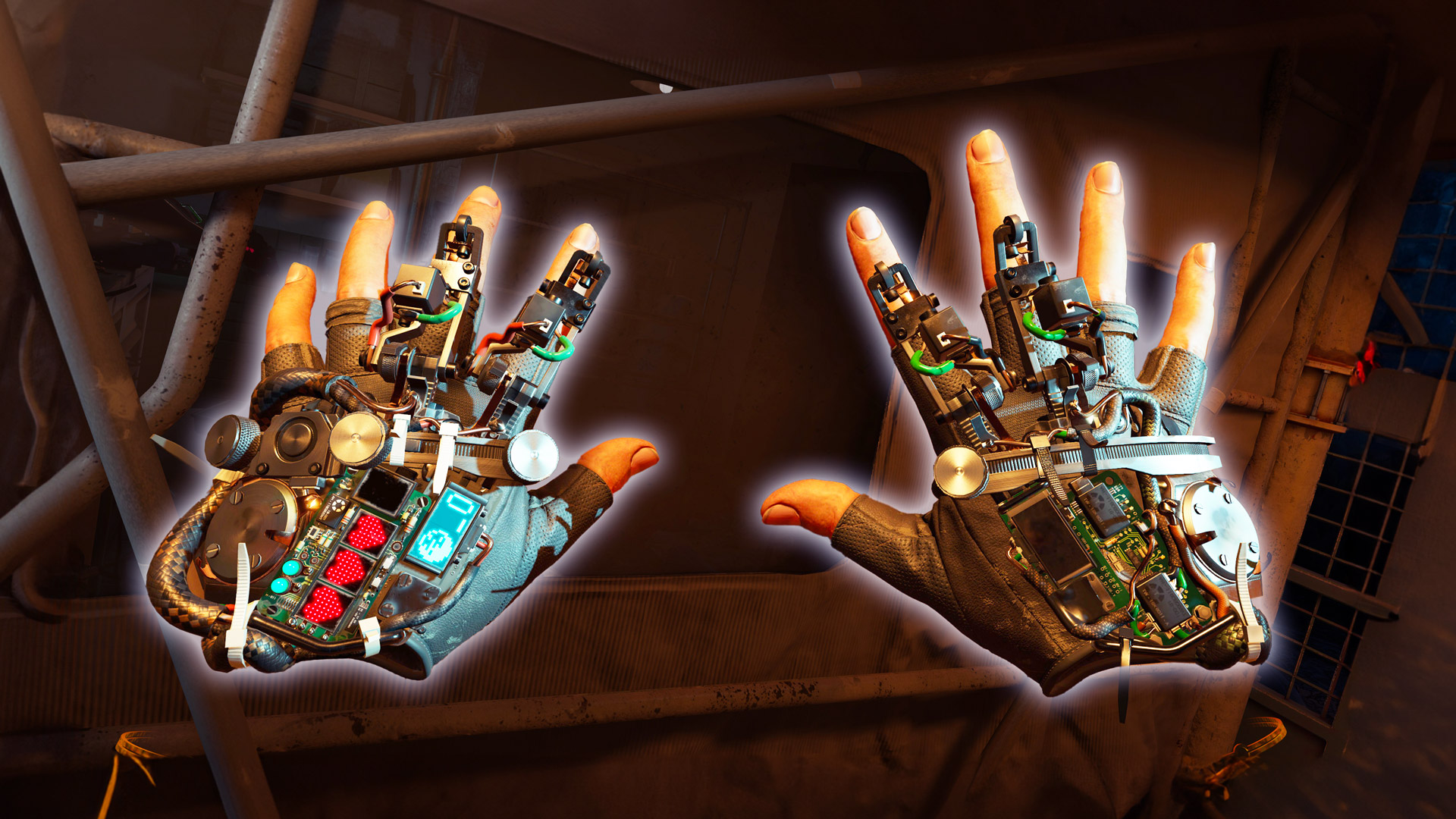In Inside XR Design we examine specific examples of great VR design. Today we’re looking at the details of Half-Life: Alyx and how they add an immersive layer to the game rarely found elsewhere.
You can find the complete video below, or continue reading for an adapted text version.
Intro
Now listen, I know you’ve almost certainly heard of Half-Life: Alyx (2020), it’s one of the best VR games made to date. And there’s tons of reasons why it’s so well regarded. It’s got great graphics, fun puzzles, memorable set-pieces, an interacting story… and on and on. We all know this already.
But the scope of Alyx allows the game to go above and beyond what we usually see in VR with some awesome immersive details that really make it shine. Today I want to examine a bunch of those little details—and even if you’re an absolute master of the game, I hope you you’ll find at least one thing you didn’t already know about.
Inertia Physics
First is the really smart way that Alyx handles inertia physics. Lots of VR games use inertia to give players the feeling that objects have different weights. This makes moving a small and light object feel totally different than a large and heavy object, but it usually comes with a sacrifice which is making larger objects much more challenging to throw because the player has to account for the inertia sway as they throw the object.
Alyx makes a tiny little tweak to this formula by ignoring the inertia sway only in its throwing calculation. That means if you’re trying to accurately throw a large object, you can just swing your arm and release in a way that feels natural and you’ll get an accurate throw even if you didn’t consider the object’s inertia.
This gives the game the best of both worlds—an inertia system to convey weight but without sacrificing the usability of throwing.
I love this kind of attention to detail because it makes the experience better without players realizing anything is happening.
Sound Design
Note: Make sure to unmute clips in this section
When it comes to sound design, Alyx is really up there not just in terms of quality, but in detail too. One of my absolute favorite details in this game is that almost every object has a completely unique sound when being shaken. And this reads especially well because it’s spatial audio, so you’ll hear it most from the ear that’s closest to the shaken object:
This is something that no flatscreen game needs because only in VR do players have the ability to pick up practically anything in the game.
I can just imagine the sound design team looking at the game’s extensive list of props and realizing they need to come up with what a VHS tape or a… TV sounds like when shaken.
That’s a ton of work for this little detail that most people won’t notice, but it really helps keep players immersed when they pick up, say, a box of matches and hear the exact sound they would expect to hear if they shook it in real life.
Gravity Gloves In-depth
Ok so everyone knows the Gravity Gloves in Alyx are a diegetic way to give players a force pull capability so it’s easier to grab objects at a distance. And practically everyone I’ve talked to agrees they work exceptionally well. They’re not only helpful, but fun and satisfying to use.
But what exactly makes the gravity gloves perhaps the single best force-pull implementation seen in VR to date? Let’s break it down.
In most VR games, force-pull mechanics have two stages:
- The first, which we’ll call ‘selection’, is pointing at an object and seeing it highlighted.
- The second, which we’ll call ‘confirmation’ is pressing the grab button which pulls the object to your hand.
Half-Life: Alyx adds a third stage to this formula which is the key to why it works so well:
- First is ‘selection’ where the object glows so you know what is being targeted.
- The second—let’s call it lock-on’—involves pulling the trigger to confirm your selection. Once you do, the selection is locked-on; even if you move your hand now the selection won’t change to any other object.
- The final stage, ‘confirmation’, requires not a button press but a pulling gesture to finally initiate the force pull.
Adding that extra lock-on stage to the process significantly improves reliability because it ensures that both the player and the game are on the same page before the object is pulled.
And it should be noted that each of these stages has distinct sounds which make it even clearer to the player what’s being selected so they know that everything is going according to their intentions.
The use of a pulling gesture makes the whole thing more immersive by making it feel like the game world is responding to your physical actions, rather than the press of a button.
There’s also a little bit of magic to the exact speed and trajectory the objects follow, like how the trajectory can shift in real-time to reach the player’s hand. Those parameters are carefully tuned to feel satisfying without feeling like the object just automatically attaches to your hand every time.
This strikes me as something that an animator may even have weighed in on to say, “how do we get that to feel just right?”
Working Wearables
It’s natural for players in VR to try to put a hat on their head when they find one, but did you know that wearing a hat protects you from barnacles? And yes, that’s the official name for those horrible creatures that stick to the ceiling.
But it’s not just hats you can wear. The game is surprisingly good about letting players wear anything that’s even vaguely hat-shaped. Like cones or even pots.
I figure this is something that Valve added after watching more than a few playtesters attempt to wear those objects on their head during development.
Speaking of wearing props, you can also wear gas masks. And the game takes this one step further… the gas masks actually work. One part of the game requires you to hold your hand up to cover you mouth to avoid breathing spores which make you cough and give away your position.
If you wear a gas mask you are equally protected, but you also get the use of both hands which gives the gas mask an advantage over covering your mouth with your hand.
The game never explicitly tells you that the gas mask will also protect you from the spores, it just lets players figure it out on their own—sort of like a functional easter egg.
Spectator View
Next up is a feature that’s easy to forget about unless you’ve spent a lot of time watching other people play Half-Life: Alyx… the game has an optional spectator interface which shows up only on the computer monitor. The interface gives viewers the exact same information that the actual player has while in the game: like, which weapons they have unlocked or equipped and how much health and resin they have. The interface even shows what items are stowed in the player’s ‘hand-pockets’.
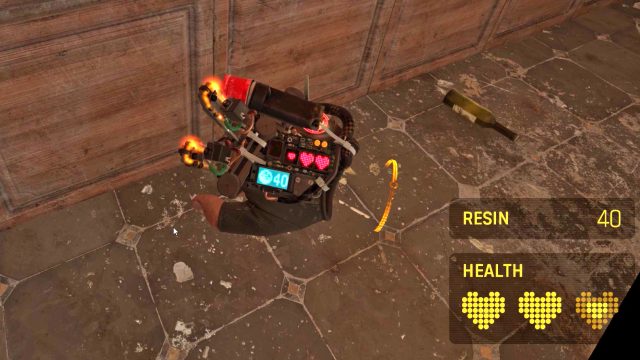 And Valve went further than just adding an interface for spectators, they also added built-in camera smoothing, zoom levels, and even a selector to pick which eye the camera will look through.
And Valve went further than just adding an interface for spectators, they also added built-in camera smoothing, zoom levels, and even a selector to pick which eye the camera will look through.
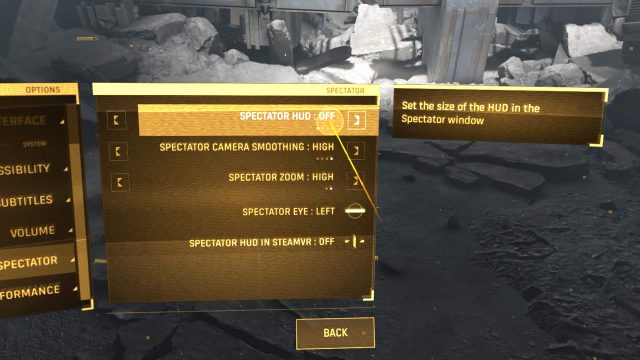 The last one might seem like a minor detail, but because people are either left or right-eye dominant, being able to choose your dominant eye means the spectator will correctly see what you’re aiming at when you’re aiming down the scope of a gun.
The last one might seem like a minor detail, but because people are either left or right-eye dominant, being able to choose your dominant eye means the spectator will correctly see what you’re aiming at when you’re aiming down the scope of a gun.
Multi-modal Menu
While we’re looking at the menus here, it’s also worth noting that the game menu is primarily designed for laser pointer interaction, but it also works like a touchscreen.
While this seems maybe trivial today, let’s remember that Alyx was released almost four years ago(!). The foresight to offer both modalities means that no matter if the player’s first instinct is to touch the menu or use the laser, both choices are equally correct.
Guiding Your Eye
All key items in Alyx have subtle lights on them to draw your attention. This is basic game design stuff, but I have to say that Alyx’s approach is much less immersion breaking than many VR games where key objects a highlighted in a glaringly obvious yellow mesh.
For the pistol magazine, the game makes it clear even at a distance how many bullets are in the magazine… in fact, it does this in two different ways.
First, every bullet has a small light on it which lets you see from the side of the magazine roughly how full it is.
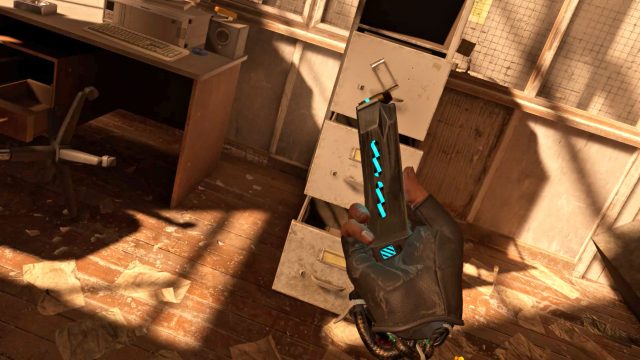 And then on the bottom of the magazine there’s a radial indicator that depletes as the ammo runs down.
And then on the bottom of the magazine there’s a radial indicator that depletes as the ammo runs down.
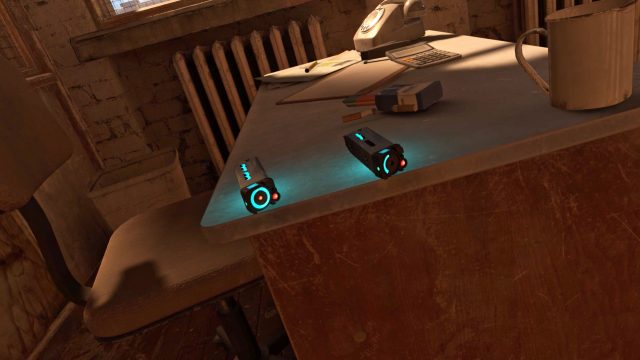 Because this is all done with light, if the magazine is half full, it will be half as bright—making it easy for players to tell just how ‘valuable’ the magazine is with just a glance, even at a distance. Completely empty magazines emit no light so you don’t mistake them for something useful. Many players learn this affordance quickly, even without thinking much about it.
Because this is all done with light, if the magazine is half full, it will be half as bright—making it easy for players to tell just how ‘valuable’ the magazine is with just a glance, even at a distance. Completely empty magazines emit no light so you don’t mistake them for something useful. Many players learn this affordance quickly, even without thinking much about it.
The takeaway here is that a game’s most commonly used items—the things players will interact with the most—should be the things that are most thoughtfully designed. Players will collect and reload literally hundreds of magazines throughout the game, so spending time to add these subtle details meaningfully improves the entire experience.
Continue on Page 2 »
-
ViRGiN
-
g-man
-
ViRGiN
-
-
XRC
,
Weapon Details
Speaking of commonly used items… it’s time to talk about guns. There’s plenty of shooting in Alyx, so Valve spent lots of time building detailed and interactive weapons. Again, shooting and reloading is something the player will do hundreds of times in the game, so it’s essential to make sure that this part of the gameplay gets lots of attention in the design.
Alyx doesn’t necessarily do anything with weapons that hasn’t been seen in other games, but it nails all of the basics… and stands as the perfect bar for how weapons should work and feel in VR if a developer wants their weapons to have a realistic feel.
So… first thing’s first… each weapon has a unique in-world ammo counter. The pistol has a segmented indicator, the shotgun has a small numeric indicator, and the Combine SMG has a radial indicator. Instead of a floating number next to the gun, these diegetic details encourage players to become intimately familiar with their weapons.
Chambering
Alyx also gets bullet chambering correct, which gives each weapon an opportunity for a feeling of player ‘mastery’ when they understand how it works.
This is a small detail that’s part of how real weapons work, and I’m sure many of you already understand chambering, but we all learned about it at some point, so for anyone who doesn’t already know, here’s how it works.
When you load a magazine into the pistol, the first bullet in the magazine needs to be ‘chambered’—or you’ve probably heard someone say ‘cocking the gun’— meaning that it’s removed from the magazine and put in place ready to fire. Now that the bullet has left the magazine, if you remove the magazine, the bullet is still in the gun and ready to fire.
When the gun is completely empty, the chamber stays open so it’s ready to receive a new bullet. But this means that if you put a new magazine into the gun before shooting the last bullet, you don’t need to cock the gun again because it’s already primed and ready to go.
And if you look at the visuals and even more importantly—listen to the sounds—it’s clear that Valve wanted to subtly convey all of this to the player.
Note: unmute the clip below to hear the sounds
First is the chambering sound so we know the gun is ready to shoot. Then you’ll hear a unique sound when your magazine is empty but the final round is still chambered. If you shoot again, you get a different sound and even lights which tell you that the gun is now completely empty and the chamber has been left open.
So that little opportunity for weapon mastery that I mentioned is for players to listen for that second-to-last shot—that is the ideal moment to reload, because it means you can put a new magazine in without needing to cock the gun again.
The same thing is true for the shotgun… it doesn’t have an ejectable magazine, but the cartridges still need to be chambered. If you shoot all of the rounds before reloading, you’ll need to cock the gun again. But if you reload on your very last shot… then you don’t need to cock the gun.
Combine SMG Reload
The combine SMG, on the other hand, doesn’t have a chambering sequence because it operates purely on sci-fi space magic.
And Valve, this is the one place where I’m gonna call you out… in this particular video. When reloading the SMG, I really want to insert the mag and then rip off that other part with a nice, satisfying sound, rather than see it just fall out of my hand to the ground. It’s just begging for that interaction.
In any case, the bullet chambering is a clever detail because many players will just shoot their weapons until completely empty and then put in a new magazine and cock the gun every time—and functionally that works fine. But those who get really familiar with what their weapon looks and sounds like can pick up on this little shortcut that saves you one extra step in the midst of combat.
Shotgun Reload
While we’re talking about reloading, it’s worth pointing out another little detail with how the game treats shotgun reloading.
If you’ve played shooters then you know the common tradeoff with a shotgun is that it’s slower to reload since it doesn’t have a separate magazine. That’s true in Alyx too, which gives the weapon some character, but Valve wanted to balance that realism with the time and effort that it takes to reload the gun.
The shotgun holds seven cartridges, which means that reloading it from completely empty would require the player to reach over their shoulder and insert a cartridge each time… 1, 2, 3, 4, 5, 6, 7. That’s a lot of repetitive movement.
Valve smartly cut’s the reload time in half by having Alyx pull out two shells every time the player reaches for their ammo.
 So a full reload happens in four gestures instead of seven… but the player still gets seven rounds. And another tiny detail is that if the shotgun only has room for one more cartridge—or the player only has one cartridge left—Alyx only pulls out a single shell.
So a full reload happens in four gestures instead of seven… but the player still gets seven rounds. And another tiny detail is that if the shotgun only has room for one more cartridge—or the player only has one cartridge left—Alyx only pulls out a single shell.
 And last but not least, when you put that last cartridge into the shotgun it makes a unique noise to let you know that it’s fully reloaded.
And last but not least, when you put that last cartridge into the shotgun it makes a unique noise to let you know that it’s fully reloaded.
People Love Plants
Ok, did I talk enough about guns yet? Let’s talk about something happier. Plants. People. love. Plants. And people also love touching plants.
If you put a plant in a VR game within someone’s reach, they will try to touch it. This is just a fact that we all must accept.
Valve clearly underwood this, as the zoo level is absolutely full of plants and you can touch them all. Not only do they react to your touch, which preserves immersion, but they also react to explosions which further makes them feel like they’re responding realistically.
Interestingly this reaction to the player also extends to the game’s alien flora, which reacts to your proximity either with lights or bulging or sometimes… jiggling…
More than Hands-on
And speaking of touching things that VR players will always want to touch… did you know that it’s actually illegal to put a piano that can’t be played in a VR game? Pretty sure that’s part of the Geneva Conventions…?
I’d be willing to bet that most players, actually, know that the piano in Half-Life: Alyx is playable—it’s kind of set up for you to discover that. But did you know it’s also playable with other objects including your gun? And yes you can even shoot the keys.
But this point isn’t just about the piano. In Alyx almost anything you can touch with your hand you can also touch with your weapons.
This seems like a minor detail, but like I talked about in episode #1, with enough time things that we hold start to feel like part of our own body, spatially speaking. We slowly gain an innate sense for where the tool starts and stops so we don’t bang it into the world around us (or into ourselves).
And like I talked about in episode #3, touching the virtual world not with our own hands but something inanimate that’s in our hands, works a bit like an immersion insulator by visually explaining why we can’t feel the things we’re touching.
Having the game reflect this reality—that the thing in our hand is an extension of ourselves—adds a certain realism that’s hard to define. It’s those moments where you don’t even think about it consciously… it just seems like a natural thing to use your gun to push open a door or swat an object out of the way.
Compared to having the weapon clip through objects and walls, like we see in many VR games, this little detail helps maintain the lie that the headset feeds to our eyes.
Vodka Bottles
And last but not least… these vodka bottles. The liquid inside is reactive to your movement which makes it feel that much more real. And yes this effect has been done in games before and since Half-Life: Alyx, but none have done them this well.
The liquid interacts with light, and even makes little bubbles when shaken up. It’s sort of mesmerizing.
– – — – –
Now a quick note before we wrap up. Half-Life: Alyx is an amazing game, and it’s so cool to see all these little details and the thinking that went into them. But I want to make sure we all understand that while it would be awesome to see this intricate level of detail in more VR games, the reality is that no VR studio has access to the number of people, the timeline, or the budget, that Valve threw at this game. So it would be unfair to see it as a failure when other VR games don’t reach this level of detail.
Alyx is a distillation of a million game design decisions, big and small, made by many people over the course of years. And if we look at it as a collection of the best ideas that made it through that gauntlet, we get the benefit of learning in just 15 hours of playtime the smart bits of design that took Valve many years to figure out. That’s a lesson we should all want to take.
If you somehow have yet to play this game, you can and should find Half-Life: Alyx exclusively on SteamVR.
Enjoyed this breakdown? Check out the rest of our Inside XR Design series and our Insights & Artwork series.
And if you’re still reading, how about dropping a comment to let us know which game or app you think we should cover next?
